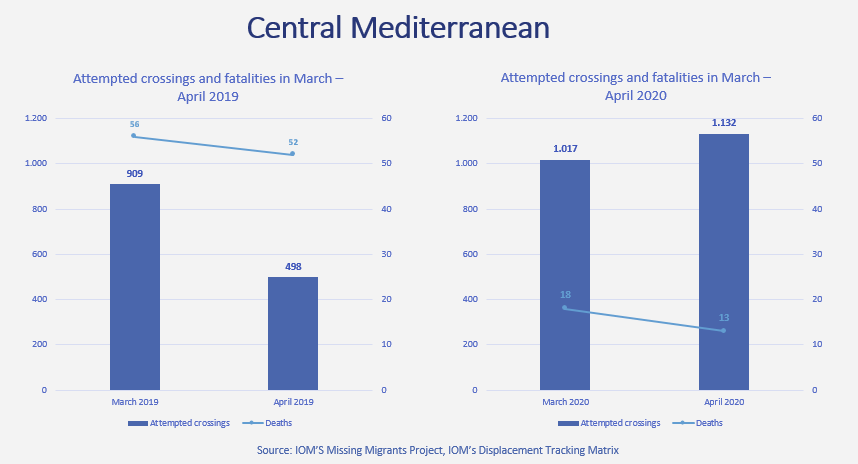-
Who we are
WHO WE AREThe International Organization for Migration (IOM) is part of the United Nations System as the leading inter-governmental organization promoting since 1951 humane and orderly migration for the benefit of all, with 175 member states and a presence in 171 countries.
-
Our Work
Our WorkAs the leading inter-governmental organization promoting since 1951 humane and orderly migration, IOM plays a key role to support the achievement of the 2030 Agenda through different areas of intervention that connect both humanitarian assistance and sustainable development.
What We Do
What We Do
Partnerships
Partnerships
- Where we work
-
Take Action
Take Action
Work with us
Work with us
Get involved
Get involved
- Data and Research
- 2030 Agenda
COVID-19 Control Measures, Gap in SaR Capacity Increases Concern About ‘Invisible Shipwrecks’
Berlin – Measures implemented by governments in response to COVID-19 including port closures, delays in disembarkation, and the reduced presence of search and rescue vessels on the increasingly busy Central Mediterranean route are raising serious concerns about the fate of vessels in distress and so-called ‘invisible shipwrecks’.
“We are seeing a steady increase in the number of vessels on the water that we are aware of, and the absence of dedicated state and NGO-led search and rescue operations makes it difficult to know all that is happening at sea,” said Frank Laczko, Director of IOM’s Global Migration Data and Analysis Centre.
“The response to COVID-19 has had a definite impact on our ability to collect accurate data. The Central Mediterranean route remains the most dangerous maritime migration route on earth and in the current context, risks that invisible shipwrecks are occurring far from the view of the international community have grown.”
GMDAC has monitored migration flows, arrival and fatalities statistics on this busy migration corridor since 2014.
Leveraging public health concerns to tighten control at their borders, the Maltese and Italian governments introduced further restrictions on disembarkation in their ports. Nonetheless, migrants continue to leave Libyan shores, driven by the deteriorating humanitarian and security situation in the country.
In April 2020, 1,132 people attempted the crossing from North Africa to Italy and Malta, based on IOM records, more than doubling the 498 people who made the journey during the same period in 2019 (see chart below).

During the COVID-19 response, the number of fatalities recorded on the Central Mediterranean route has decreased in 2020 from 18 deaths and 13 deaths in March and April respectively, down from 56 and 52 during the same months last year.
“Our feeling is that this is not an accurate reflection of the current situation,” Laczko said.
The lack of assistance at sea has resulted in the deaths and disappearances of people travelling on this route, stranding migrants at sea on flimsy, unseaworthy boats for days without rescue. At least 12 people lost their lives on the Easter weekend (12 April), after drifting for days in a rubber boat somewhere between Libya and Malta.
Meanwhile public health measures adopted in response to the pandemic have forced many search and rescue NGOs to curtail their activities. Only two NGO rescue vessels have been patrolling the Central Mediterranean during these recent months: the Aita Mari and the Alan Kurdi. Both are now being held in the Port of Palermo for administrative reasons.
Migration along two other Mediterranean routes has been affected differently by the COVID-19 restrictions. In the Eastern Mediterranean, the number of people attempting the crossing – including those who arrived in Greece and those intercepted at sea and returned to Turkey – dropped to 292 in April 2020. This represents a sharp decrease relative to March, when 4,905 people attempted passage. It is likely that the containment measures implemented by Turkey – including mandatory quarantine, travel bans and movement restrictions – coupled with increased patrolling by Greek authorities have cut into mobility across the Aegean.
Overall arrivals to Spain since the onset of the pandemic also have dropped. Some 1,098 people were recorded arriving via land and sea routes during the six weeks between Spain’s lockdown, and 30 April. That’s down 45 per cent from the same period last year, when 1,998 people were recorded.
Land border closures and strict confinement policies may have contributed to the decrease in the number of people attempting the journey. However, while arrivals to mainland Spain, Ceuta and Melilla via the Western Mediterranean route have dropped, the upward trend of arrivals to the Canary Islands continues. Spain’s Ministry of the Interior reported that 706 migrants were rescued off the coast of the Canary Islands between 15 March and 30 April. Only 135 people were recorded arriving via this route during the same period in 2019.
Tragically, not all boats that set out for the Canary Islands arrive. IOM’s Missing Migrants Project recorded the deaths of 63 people in two shipwrecks on this route during March and April 2020.
Missing Migrants Project data are compiled by IOM staff based at its Global Migration Data Analysis Centre (GMDAC). For latest arrivals and fatalities in the Mediterranean, click here. Learn more about the Missing Migrants Project.
For more information please contact Safa Msehli at IOM Geneva, Tel: +41 79 403 5526. Email: smsehli@iom.int